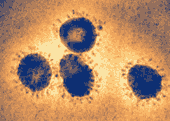SARS-CoV nsp7 and nsp8
Introduction
The outbreak of SARS in Hong Kong almost caused and pandemic and created a worldwide panic. From late 2002 to July 2003, there were about 8,273 cases and 775 deaths. People who are infected often have muscle pain, headache, fever as well as respiratory symptoms such as cough and pneumonia. The disease is known to infect older people with mortality rate the highest for those over 50 years old. Also known as severe acute respiratory syndrome, SARS has not been eradicated and can return to infect the human population. Since no antibiotics, antivirals, steroids, and therapies are known to be effective against this viral disease, it has become a top priority for the government and public health scientists around the world to identify and develop vaccines and medicine to prevent another outbreak.
Severe acute respiratory syndrome is caused by a SARS coronavirus (SARS-CoV). SARS-CoV is a positive strand RNA virus that causes respiratory and enteric disease. Viral replication of the coronavirus genome replication takes place in the cytoplasm. Infection by the coronavirus can alter cell cycle, transcription and translation pattern as well as induce apoptosis and inflammation. SARS-CoV was identified by a number of laboratories to be the main cause of SARS. In April 2003, Michael Smith Genome Sciences Centre, located in Vancouver, became the first lab in the world to sequence the coronavirus that causes SARS using samples from infected patients in Toronto. The mapping of the SARS-CoV is a step forward to fighting SARS. With this sequence, scientists can began to understand more about the coronavirus structure, function and genome replication as well as began antiviral research against SARS coronavirus.
The discovery of the SARS-CoV has propelled extensive studies on its viral replication. Non-structural proteins 7 and 8 (nsp(7+8)) have been identified to be involved in the coronavirus replication and transcription. Furthermore, the interaction between nsp(7+8) is important for RNA-dependent RNA polymerase (RdRp) activities of the SARs-coronavirus genome. By understanding the structures of these non-structural proteins, scientists are one step closer to decipher the mechanism of SARS-CoV genome replication and may even use them to develop new strategies for the prevention or treatment of SARS in animals and humans.
Structure and interaction of nsp 7 and nsp 8
The transcription and replication machinery of SARS-CoV can be understood from its structure. Yujia Zhai et al., was able to present the crystal structure of the hexadecameric nsp7-nsp8 supercomplex of SARS-CoV at 2.4-A resolution. This structure is considered to be the first to show interactions between coronavirus replication proteins as well as the architecture of the coronavirus replication and transcription machinery.
The structure of the supercomplex resembles a hollow cylinder with a central channel that has two handles protruding from opposite sides. It is assembled from eight copies of nsp8 and bound tightly together by eight copies of nsp7. Nsp7 is an alpha helical protein of about 10kDA. It has single domain with a novel fold that consists of five helical secondary structures. The interhelical side-chain interactions that stabilize and hold the helices together have residues that are predominantly hydrophobic. Nsp7 localizes to cytoplasmic membrane structures that are also known to be the sites of viral replication in infected cells. SARS-CoV nsp7 dimerizes and interact with other protein such as nsp5, nsp8, nsp9 and nsp13. Nsp7 central core consists of an N-terminal helical bundle (HB) that contains helices HB1, HB2, and HB3. Its HB region is conserved and is known to interact with nsp8. Nsp8 has a molecular mass of about 22kDa and is unique for coronaviruses. The four monomers of nsp8 has two different conformations: nsp8I and nsp8II. Nsp8I is described as a “golf-club” like structure composed of an N-terminal “shaft” domain that contains three helices (NH1-3) and a C-terminal “head” domain while nsp8II 2 has a similar “head” domain, but its shaft helix NH3 bends into two shorter helices.
Section 2
Include some current research in each topic, with at least one figure showing data.
Section 3
Include some current research in each topic, with at least one figure showing data.
Conclusion
Overall paper length should be 3,000 words, with at least 3 figures.
References
Edited by (your name here), a student of Nora Sullivan in BIOL187S (Microbial Life) in The Keck Science Department of the Claremont Colleges Spring 2013.

